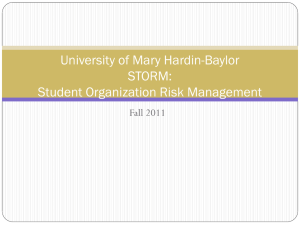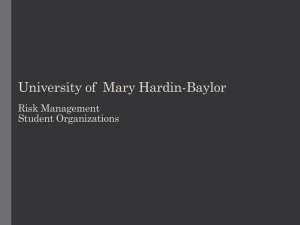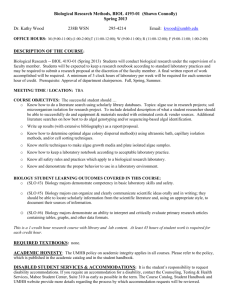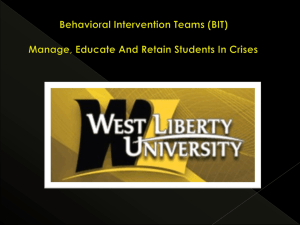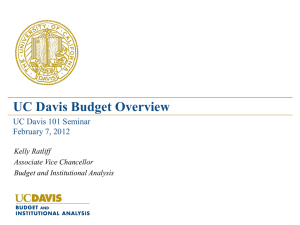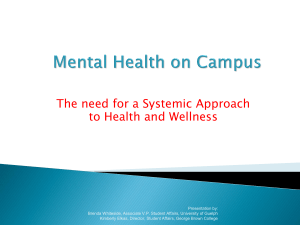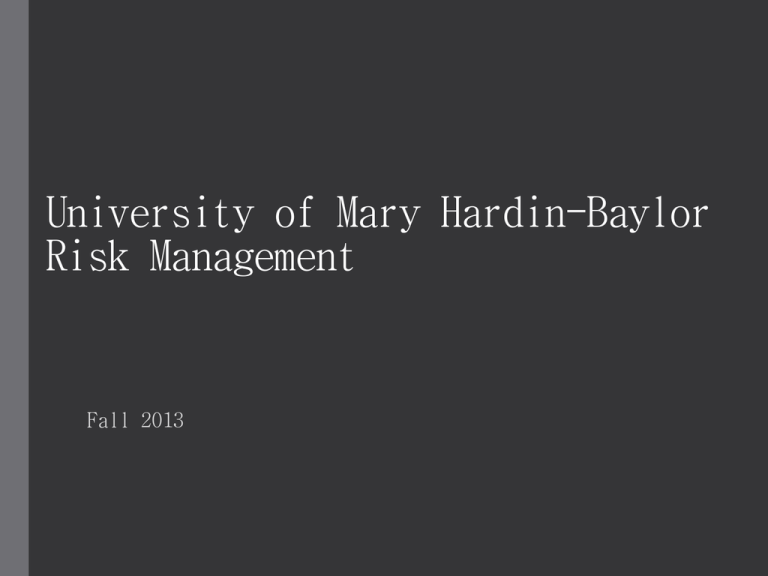
University of Mary Hardin-Baylor
Risk Management
Fall 2013
Student Organizations
and Safety Department
•
Student Organizations
Tiffany Wurdemann – twurdemann@umhb.edu
Katy Bumpus - kbumpus@umhb.edu
•
Safety Department
Larry Pointer – lpointer@umhb.edu
Texas S.B. 1138
•
Requires all student organization officers and advisors to attend a Risk
Management program hosted by the University
Each organization must send:
3 officers on an annual basis
1 advisor every three years
http://www.legis.state.tx.us/tlodocs/80R/billtext/html/SB01138F.htm
Texas S.B. 1138
•
Presidents have until October _7,2013 to present the Risk
Management PowerPoint to their membership.
•
An attendance log certifying membership attendance of
the Risk Management PowerPoint presentation should be
submitted by October _11__, 2013 before 5pm.
FUNDING WILL NOT BE GRANTED WITHOUT THIS
DOCUMENTATION
Risk Management Program
Required program content:
•
Alcohol and Drugs
•
Hazing
•
Sexual abuse & harassment
•
Fire & Safety
•
Travel
•
Behavior
•
Risk Management policy
What is Risk Management?
Risk Management is the process of
considering the potential risks to Students and
the University ,as well as identifying ways to
avoid the dangers of activities.
Types of Risk
Physical:
Example: Food poisoning, injuries from physical activities, injuries from travel
related accidents.
Reputation:
Example: Negative publicity for UMHB, your organization, your advisor and/or
the venue where you are holding event.
Emotional:
Example: Causing a participant at your event to feel alienated or negatively
impact the feelings of a member or members of the UMHB community.
Types of Risk
Financial:
Example: Things that can negatively impact the fiscal stability of your
organization and/or other organizations financially supporting your event.
Facilities:
Example: Things which may cause property damage and/or prevent event from
being held;
bad weather
not enough space for the number of participants
lack of equipment or materials needed for the event.
Types of Risk
Information:
Example: Personal information must be protected under various laws to protect
individuals.
FERPA – Family Education Rights & Privacy Act
GLBA – Gramm-Leach Bliley Act (financial)
HIPAA – Health Ins. Portability & Accountability Act
Student Handbook
Violation of the Student Handbook can
warrant one or more of the following:
•
Censure – oral or written warning
•
Reprimand – written warning
•
Probation -written notice/prohibit participation in activities
•
Restitution – reimburse or compensate
•
Eviction – probation or removal from campus facilities
•
Suspension – termination of student status for specified time
•
Expulsion – permanent termination of student status
Student Handbook
Violation of state law, city ordinance or university
regulations will also be considered grounds for
disciplinary action.
UMHB Policies
•
Student Handbook
•
Student Rights & Responsibilities
•
Posted on My Campus / Student Life
Alcohol / Illegal Drugs
UMHB follows a ZERO Tolerance policy;
•
Applies to all students whether they are considered a minor or are over
the age of 21
•
Applies both on and off campus.
•
Covers the following actions:
Possession
Use (includes returning to campus after the use of)
Purchasing
Being under the influence
Alcohol / Illegal Drugs
Federal Penalties & Sanctions – Drugs & Alcohol
21 USC 844 (possession of controlled substances)
•
1st conviction; up to 1 yr. imprisonment & fine $1,000 - $100,000 or both.
•
After 1 prior conviction; 15 days – 2 yrs. & fine $2,500 - $250,000 or both.
•
After 2 or more convictions; 90 days – 3 yrs. & fine $5,000 - $250,000 or both.
State Penalties & Sanctions – Drugs & Alcohol
Texas Penal Code;
Public intoxication - $500 fine.
DUI/Driving under influence – fine up to $10,000 and/or 3 days to 10 yrs. in prison.
Texas Alcohol Beverage Code;
Purchase, possession or consumption under 21 yrs. – fine $500 - $2,000.
Texas Health & Safety Code;
•
Illegal distribution, possession, or use of controlled substances – 5 yrs. to life in prison – up to $20,000 fine.
•
Possession of marijuana – 2 to 20 yrs. in prison – up to $10,000 fine.
•
Distribution of marijuana – 5 to 99 yrs. in prison – up to $50,000 fine.
Hazing
As defined by the Education Code:
“Any intentional, knowing, or reckless act occurring on
or off campus, by one or more persons, directed against
a student for the purpose of pledging, being initiated
into, affiliating with, holding office in, or maintaining
membership in an organization. It is a criminal
violation under Texas law.”
Hazing
SUBTLE HAZING: Behaviors that emphasize a power imbalance between new
members/rookies and other members - often accepted as “harmless”.
•
Deception
•
Name calling
•
Assigning demerits
•
Socially isolating new members/rookies
•
Silence periods with implied threats for violation
•
Deprivation of privileges granted to other members
•
Line-ups and Drills/Tests on meaningless information
•
Expecting certain items to always be in one's possession
•
Requiring new members/rookies to perform duties not assigned to
other members
•
Requiring new members/rookies to refer to other members with titles
(e.g. “Mr.,” “Miss”) while they are identified with demeaning terms
Hazing
HARASSMENT HAZING: Behaviors that cause emotional anguish or
physical discomfort in order to feel like part of the group. Harassment
hazing confuses, frustrates, and causes undue stress.
•
Verbal abuse
•
Sleep deprivation
•
Sexual simulations
•
Expected to harass others
•
Threats or implied threats
•
Stunt or skit nights with degrading, crude, or humiliating acts
•
Asking new members to wear embarrassing or humiliating attire
•
Expecting new members/rookies to perform personal service to other
members such as carrying books, errands, cooking, cleaning etc
•
Expecting new members/rookies to be deprived of maintaining a
normal schedule of bodily cleanliness.
Hazing
VIOLENT HAZING: Behaviors that have the potential to cause physical
and/or emotional, or psychological harm.
•
Burning
•
Bondage
•
Branding
•
Public nudity
•
Water intoxication
•
Abductions/kidnaps
•
Expecting illegal activity
•
Beating, paddling, or other forms of assault
•
Expecting abuse or mistreatment of animals
•
Forced or coerced alcohol or other drug consumption
•
Forced or coerced ingestion of vile substances or concoctions
•
Exposure to extreme cold heat without appropriate protection
Sexual Abuse / Harassment
Sexual Harassment Policy
UMHB will NOT tolerate any form of verbal or
physical conduct that harasses, disrupts, or interferes
with another individual or creates an intimidating,
offensive, or hostile environment.
Sexual Abuse / Harassment
Prohibited conduct includes but is not
limited to:
•
Sexual flirtation
•
Improper / unwanted touching
•
Advances, propositions, or pressure for sex
•
Verbal abuse (all forms)
•
Direct or implied threats coercing submission to
improper conduct
•
Display of sexually suggestive object, pictures, or
photos.
Sexual Abuse/Harassment
Health and Counseling Center
254-295-4696
Student Life Office
254-295-4496
Dean of Students
254-295-4590
Campus Police
254-295-5555
Belton Police
254-933-5840
Fire & Life Safety
If you discover a fire:
•
Activate the nearest fire alarm pull station
– located at or near each exit.
•
Evacuate immediately
– Go to your designated “Emergency Assembly Point” (EAP)
- list in Safety Manual Sect. 6.0
If the fire alarm sounds:
•
Evacuate immediately – to the EAP.
Note: Do not return to the building until cleared and re-entry
authorized by Campus Police.
Emergency Preparedness
Emergency Sirens:
• Two
locations:
At 10th Ave. and College Street
On Parker Dr. (behind McLane Hall)
• Activated
for various events:
haz-mat incident
tornado warning
shooter in vicinity
• When
the sirens are activated :
SHELTER-IN-PLACE
Check CRU Alert
Check UMHB website
Remain sheltered until notified “all clear”
Emergency Preparedness
TORNADO
•
Watch – conditions favorable
stay close to “home”
•
Warning – tornado sighted/detected
Shelter-in-Place immediately
On lowest floor
In most interior rooms w/o windows
Remain sheltered until “all clear”
Important: Do NOT shelter in hallways & corridors (unless
absolutely necessary) - lesson learned from the Joplin, MO
tornado in 2011.
Emergency Preparedness
Haz-Mat Incident
Example: Leaking chemical railroad car
Shelter-in-Place
Get everyone inside immediately
Close doors & windows
Turn AC/Heat system off
Remain sheltered until “all clear”
Emergency Preparedness
Shooter/Person w/weapon
•
Shelter-in-Place immediately
•
Lock and/or barricade doors
•
Shelter in interior rooms
i.e. out of sight
•
Report to Campus Police – 5555
•
Remain sheltered until “all clear”
Firearms and Explosive Devices
• Prohibition
includes:
Individuals who are licensed to carry firearms,
All vehicles.
Use, storage, or possession of weapons or dangerous devices including, but not
limited to:
Firearms
Ammunition
Martial arts devices
Knives
Sling shots
Air powered guns
Blow guns
Fireworks
Flammable liquid.
Possession of a weapon or threat of use of a weapon may result in immediate
expulsion in addition to the filing of criminal charges.
Crime Prevention
In order to make UMHB a safer community, the Police
Department asks that you practice the following crime prevention
techniques:
•
To report a police, fire, or medical emergency, or to report a
crime in progress, dial 911 FIRST and 5555 IMIDIATLY after
from any campus telephone.
•
While on campus at night, use the "buddy" system. If you find
that you must go somewhere on campus by yourself, call the
police department for an escort.
Crime Prevention Continued
•
During hours of darkness, walk along lighted pathways. Stay on the
lighted paths.
Emergency Call boxes located around campus.
Push Red Button
Automatically notifies Campus Police
•
Alarm your vehicle to discourage would-be thieves from breaking into
your automobile.
•
When you see something suspicious, get the University Police involved
by calling 5555 on campus.
Travel & Transportation
All travel must be approved
•
Must be accomplished in accordance with the UMHB Student Organization
Transportation Policy.
•
Participation in such off-campus trips and activities is at the student’s own risk.
•
Faculty and staff advisors of such trips and organization officers are urged to take
all possible precautions to insure the safety and well-being of all persons
participating in the activity.
Travel & Transportation
• All
drivers must possess a valid driver’s
license.
• Drivers
utilizing personal vehicles must
be at least 18 years of age
• Drivers
utilizing university vehicles must
Be 21 years of age &
complete the STARS driving program
Travel & Transportation
•
Personally owned vehicles used by members of student
organizations for travel must be maintained in
compliance in respect to State requirements:
Valid insurance
Valid registration
Valid State inspection (tires, lights, wipers, brakes,
horn, etc.)
Travel & Transportation
Insurance & Responsibility
•
The Member’s vehicle insurance serves as primary
insurance coverage for third-party liability and
physical damage to the owner’s vehicle.
•
The Member must assume personal responsibility for
any and all fines or traffic violations associated with
the use of their personal vehicle.
Travel & Transportation
Disqualification
Drivers will be disqualified for
•
Accumulation of 6 points (3 moving violations).
•
Exceeding the speed limit in excess of 20 miles per hour.
•
Driving under the influence of alcohol or drugs.
•
Offenses against a person involving a vehicle.
Drivers must notify their respective Advisor and Student Organization Director
immediately if any conditions occur such as those listed above that would disqualify
them from driving for the organization.
Travel & Transportation
Drivers and passengers must use seat belts at all times
when vehicle is in motion (one person per seat belt).
Drivers must
• Obey all traffic laws at all times
•
Take 15 minute break every 4 hours
•
Not drive more than 10 hours in any 24 hr. period
•
Have at least 2 drivers for trips over 400 miles
•
Drive with headlights on at all times
•
Not use electronic devices (i.e. cell phone) while
driving
Insurance & Risk
UMHB requires:
ARA - Acknowledgement & Release Agreement (Waiver) signed
by all participants
18 years and older, for
All high risk activities
(<18 – signed by Parent/Legal Guardian)
Certificates of Liability Insurance
For all vendors/contractors doing business on campus
Approved by the UMHB Business Office
Safety Program
• Report
security issues/concerns:
Theft, vehicle damage, etc. to
Campus Police at 295- 5555.
• Report
safety issues/concerns:
Dorms/Apartments: Residence Life Staff
Academic/Admin Bldgs: Building Coordinators
Bldg. Coordinator List: Safety Manual Sect. 2.0
Campus: Safety Director at 295 – 8635.
Safety Program
Reporting
Report student associated threats/concerns to the
UMHB STAT –
Student Threat Assessment Team.
Intervention, support, response
Students w/disruptive, disturbed, distressed behaviors
Primary Contacts:
Ray Martin, Dean of Students
Nate Williams, Dir. Counseling & Testing
Gary Sargent, Dir. Campus Police
Other Members: Dr. Weathersbee, Dr. Loutherback, Joy Muller, Donna
Plank, Debbie Rosenberger, Susan Owens, Larry Pointer
My Campus/Student Affairs/STAT/STAT Situation Report
What is Risk Management?
Risk Management is the process of
considering the potential risks to Students and
the University ,as well as identifying ways to
avoid the dangers of activities.

